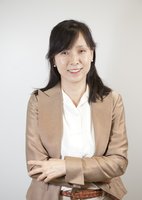This story was originally published on the U of T Physics website.
The Canadian Association of Physicists (CAP) is pleased to announce that the 2023 CAP/DCMMP Brockhouse Medal is awarded to Professor Hae-Young Kee, University of Toronto, in recognition of her theoretical work in a variety of strongly correlated electron systems, particularly those in which spin-orbit coupling is important. Her work has emphasized identifying appropriate model Hamiltonians that have led to new insights and predictions. Her work on α-RuCl3 and novel phases arising from spin-orbit coupling in iridates has been particularly impactful.
Professor Hae-Young Kee is recognized as one of the world’s foremost theoreticians in identifying new quantum materials with desirable functionalities. She has uncovered microscopic models that elucidate the fundamental physics behind complex many-body systems. These models provide direct insight into perplexing physical phenomena and offer theoretical guidelines to ground-breaking discoveries.
I am deeply honoured to receive the 2023 CAP Brockhouse medal, a remarkable recognition from the Canadian physics community. I am extremely grateful for the invaluable contributions of my talented students, postdoctoral fellows, collaborators, and colleagues, as well as the unwavering support of my friends and family.
Kee has made profound contributions to understanding strongly correlated electron systems in which electron-electron interactions are so strong that standard theory fails. Her work has fueled the widespread search for novel magnetic materials, topological insulators, metals, and superconductors. Our knowledge of quantum matter has advanced through a series of her discoveries. Among them, her generic spin model and proposed candidate material α-RuCl3 for the so-called Kitaev spin liquids have greatly advanced research on quantum magnetism. Kitaev spin liquids offer entangled particles whose braiding statistics can be used to encode quantum information. Another breakthrough is her discovery of a new class of nodal-line metals that she named a topological crystalline semi-metal. This remarkable work has generated great attention and her prediction of the nodal ring in the three-dimensional iridium oxide SrIrO3 has been confirmed in experimental labs.
Kee expertly integrates the knowledge and insight of research communities in experimental and theoretical physics, leading international collaborative projects with both types of researchers. She has organized many international workshops, including Quantum Materials Canada, and has an exceptional record of training and mentoring junior researchers. Kee’s research has expanded the boundaries of our understanding of microscopic routes to collective quantum phenomena in topological materials and inspired experimental searches for novel materials essential for modern quantum technology. Kee’s contributions have been recognized by a Sloan Fellowship, APS Fellow, Fellow of the CIFAR Quantum Materials Program, Distinguished Fellow at the Asia Pacific Center for Theoretical Physics, and Tier I and II Canada Research Chairs.

